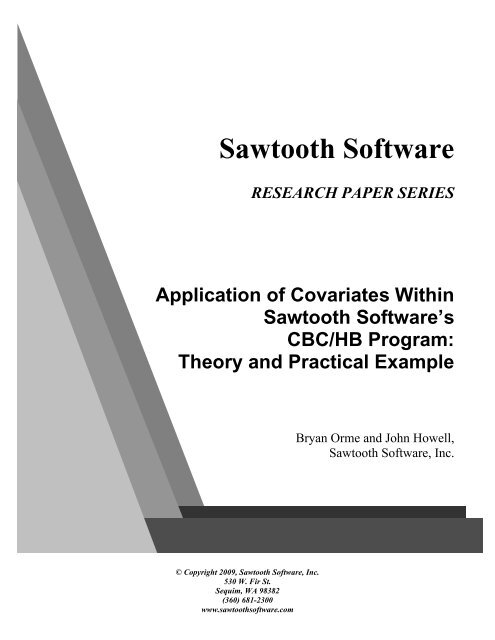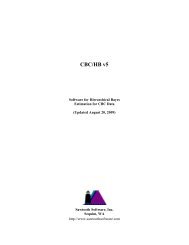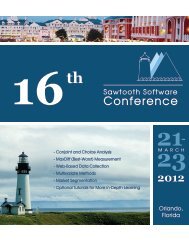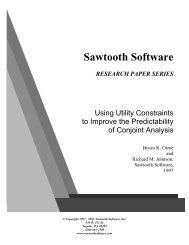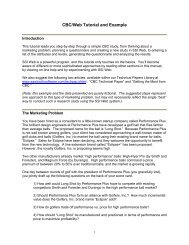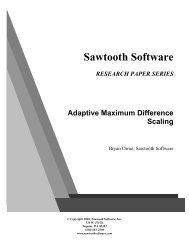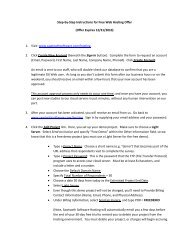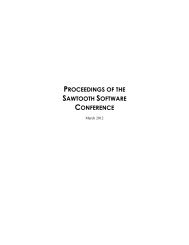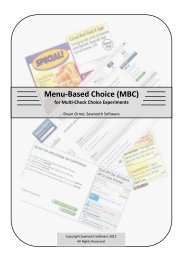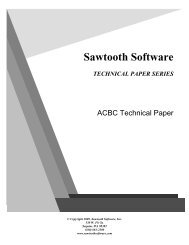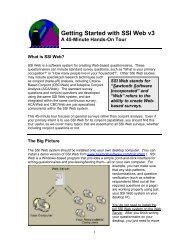Download Paper - Sawtooth Software, Inc.
Download Paper - Sawtooth Software, Inc.
Download Paper - Sawtooth Software, Inc.
- No tags were found...
Create successful ePaper yourself
Turn your PDF publications into a flip-book with our unique Google optimized e-Paper software.
<strong>Sawtooth</strong> <strong>Software</strong>RESEARCH PAPER SERIESApplication of Covariates Within<strong>Sawtooth</strong> <strong>Software</strong>’sCBC/HB Program:Theory and Practical ExampleBryan Orme and John Howell,<strong>Sawtooth</strong> <strong>Software</strong>, <strong>Inc</strong>.© Copyright 2009, <strong>Sawtooth</strong> <strong>Software</strong>, <strong>Inc</strong>.530 W. Fir St.Sequim, WA 98382(360) 681-2300www.sawtoothsoftware.com
Application of Covariates within <strong>Sawtooth</strong> <strong>Software</strong>’s CBC/HB Program:Theory and Practical Example1 Bryan Orme and John Howell, <strong>Sawtooth</strong> <strong>Software</strong>Copyright 2009, <strong>Sawtooth</strong> <strong>Software</strong>, <strong>Inc</strong>.Importance of CBC (Choice-Based Conjoint)Over the last decade, hierarchical Bayes (HB) estimation of part-worths has had a significant andpositive impact on the analysis of discrete choice (CBC) data. Certainly, HB has been key to theemergence of CBC (Choice-Based Conjoint) as the most popular conjoint-related method(<strong>Sawtooth</strong> <strong>Software</strong>, 2003). <strong>Sawtooth</strong> <strong>Software</strong> released its CBC/HB software for estimatingpart-worths from CBC questionnaires in 1999, based on earlier work published by Greg Allenbyand Peter Lenk (Allenby et al. 1995, Lenk et al. 1996), as well as workshops given by Allenby &Lenk at the American Marketing Association’s ART/Forum conferences. Although the focus ofthis paper is on the use of CBC/HB for analyzing CBC data, similar data such as MaxDiff willalso benefit from the use of covariates.The Basic Hierarchical ModelHierachical Bayes models require repeated measures per respondent. In CBC questionnaireseach respondent picks the best alternative from multiple choice tasks. Repeated measures areneeded to measure within- and between-respondent variation. The hierarchical Bayes model iscalled hierarchical because it models respondents’ preferences as a function of an upper-level(pooled across respondents) model and a lower level (within-respondents) individual-levelmodel. At the individual-level, the respondent is assumed to choose product concepts accordingto the sums of part-worths as specified in the logit model. The lower-level model is also astandard feature of non-Bayesian models. The upper-level model describes the heterogeneity inthe individual part-worths across the population of respondents. At the upper-level, the basic HBapproach assumes that respondents are drawn from a multivariate normal distribution, with partworths(ß i ) distributed with means α and covariance matrix D, ß i ~ Normal(α, D), where thesubscript i is the respondent. HB determines the optimal weight of the upper level and lowerlevel models in estimating part-worth estimates for each individual, resulting in high posteriorprobability that the part-worths (ß i ) fit respondent choices, given that respondents are drawnfrom the population distribution. In application, the upper-level model plays the role of a priorwhen estimating each respondent’s part-worths, and the lower-level model provides thelikelihood. Because it leverages information from the population parameters α and D, HB is ableto estimate stable and useful part-worths for each individual even in the case of relatively sparsedata.Versions 1 through 4 of <strong>Sawtooth</strong> <strong>Software</strong>’s CBC/HB program used a simple assumption: thatrespondents were drawn from a single population of normally distributed part-worths.1 The authors gratefully acknowledge Rich Johnson, Peter Lenk, and Jeffrey Dotson who provided helpfulcomments and suggestions regarding this article.1
Throughout this paper we will refer to this as generic HB. While this assumption may seemoverly simple, it actually performs quite well in practice. The single-normal-populationassumption is only an influencing factor on the final part-worth estimates, and does not constrainthe final part-worths to reflect normality. Since HB represents a weighted combination of theupper- and lower-level models, if enough information (i.e. choice tasks) is available at theindividual-level, the influence of the upper-level model is much less than the lower-level model,which seeks only to fit each individual’s choices. For example, the authors have seen bimodaldistributions for a brand part-worth result from HB estimation of CBC data, because the strongbimodal preference for the brand as exhibited by individuals in the sample was an overridingfactor in the weighting. The influence of the upper-level model provides some degree ofBayesian shrinkage toward the global mean, which tends to smooth the distribution somewhat,with a tendency toward normality. But again, if a substantial number of choice tasks areavailable relative to the number of parameters to be estimated (as is typical with CBCapplications in practice), the Bayesian shrinkage is usually modest, making the troughs less deepin multi-modal distributions of preference, and drawing the means for distinct populations ofrespondents closer together. The bottom line based on extensive simulation studies andexperience is that HB estimation is fairly robust to the normal assumption of part-worthheterogeneity.The Possibility of CovariatesDespite the general success of CBC/HB software with the assumption of single populationnormality, there are some instances where CBC/HB users have raised concerns:• In situations in which a segment of respondents (with divergent preferences) isoversampled, this can bias the estimates for the segment means as well as the overallpopulation means – which especially can bias the betas for the undersampled group ofrespondents (Howell, 2007).• When conducting segmentation studies, some researchers have expressed concern thatdistances between segment means are diminished (because HB shrinks the individualestimates of the part-worths towards the population mean), whereas clients like to seelarge differences between segments.• Advanced HB practitioners have recommended that in many cases, well-chosencovariates can provide additional information to improve parameter estimates andpredictions.• The notion that respondents are drawn from a single normal population has struck manyresearchers and their clients as unrealistic.Some early applications of HB estimation of part-worths for conjoint experiments used a moreflexible definition of the upper-level model in HB (Lenk et al. 1996). Rather than assuming thatall respondents were drawn from a single multivariate-normal distribution, they allowed a moreflexible definition of the population distribution based on respondent characteristics (covariates).Covariates is another term for additional independent variables that may be predictive of someoutcome (the dependent variable). Often, we think of covariates such as common demographicslike gender, age, income, company size, geographic location, etc. Unfortunately, these variablesoften have low correlation with preferences within choice contexts. The most useful covariates2
ing exogenous information (outside the information already available in the choice tasks) to themodel to improve the estimates of part-worths and improve market predictions. In the exampleshown in this paper, the dollar amount respondents expected to pay for their next PC purchasewas a useful covariate to improve part-worth estimates that included such attributes as brandpreference, PC performance, and price sensitivity.More formally, rather than assume respondents are drawn from a normal distribution with meanvector α and covariance matrix D, an HB model with upper-level covariates assumes thatrespondents’ part-worths are related to the covariates through a multivariate regression model:β i = Θ’z i + ε i where ε i ~ Normal(0,D)where Θ is a q by b matrix of regression parameters, z i is a q vector of covariates, and ε i is a bvector of random error terms. The part-worths are drawn from a normal distribution with meansΘ’z i . Instead of shrinking the individual estimates to the population mean α, the multivariateregression model shrinks them to the conditional mean Θz i given the subject’s covariates. Forexample, if gender is a covariate, and preferences differ between the genders, then a woman’spart-worths are shrunk toward those of other women, while a man’s part-worths are shrunktoward those of other men. In contrast, generic HB shrinks both men’s and women’s part-worthsto a common population mean for all subjects. In this way, the multivariate regression, upperlevelmodel can automatically use observed, segment basis variables (e.g. Gender, SecuritySeeking, Experience, etc.) to refine the estimation of the part-worths and increase the distinctionbetween segments.If there are n subjects in the study, the model for all of the {β i } can be written in matrix notation,which we give here for completeness. Let B be a n by b matrix where the i th row consists of thepart-worths β i for subject i. ThenB = ZΘ + Δwhere Z is a n x q matrix with z i in the i th row; Θ is a q by b matrix of regression coefficients,and Δ is a matrix normal distribution with ε i in the i th row.In the generic HB model with the single normal population assumptions, there are b + [b(b+1)]/2parameters to be estimated in the upper-level model, where b is the number of part-worths foreach individual. Breaking that equation down, assuming there are b parameters for the meanpopulation parameters (α), and since the covariance matrix (D) is symmetric, there are [b(b+1)]/2parameters to estimate on and above the diagonal. With covariates in the upper-level model,there are bq parameters to be estimated in the upper model, where b is the number of part-worthsand q is the number of covarariate parameters (dummy-coded for categorical variables, and withthe possibility of continuous variables). If Gender was the covariate, consisting of males andfemales, q would equal 2. There would be one set of parameters (for each part-worth) for theintercept and one additional set of parameters (again, one for each part-worth) for the dummycontrast between males and females. <strong>Inc</strong>luding covariates in the upper-level model doesn’t alterthe estimation of covariance matrix D. This makes it a more parsimonious model than separatingthe sample by gender and running generic HB within the separate samples. In that case, the3
vector of sample means (16 parameters, in our example that follows)) plus the covariance matrixconsisting of [16(16+1)]/2 = 136 parameters would have to be estimated for the upper model ineach sample. Estimating as a single HB run with a dummy-coded covariate for gender saves 136parameters in the upper-level model versus segmenting the data set and running generic HBwithin the separate samples. A few covariate columns (when dummy-coded) added to an HB runincreases the length of the run time, but typically by only about 10 to 25%.The covariates HB model can be estimated in much the same way as the generic HB model usingMCMC and a Gibbs Sampler. The only difference is that instead of using a common α for allrespondents, respondents are compared to their predicted mean based on the characteristics intheir specific ZΘ vector. In addition, instead of estimating α from a multivariate normaldistribution, Θ is drawn from a Matrix Normal distribution with means 0 and variances 100. Formore details on MCMC and the Gibbs Sampler please see the CBC/HB Technical <strong>Paper</strong> from<strong>Sawtooth</strong> <strong>Software</strong> (<strong>Sawtooth</strong> <strong>Software</strong> 2005).<strong>Sawtooth</strong> <strong>Software</strong> investigated extending the CBC/HB software to include covariates in theupper-level model as early as about 2001. Peter Lenk was helpful to us as we developed codefor that investigation. After examining a few data sets, our feeling was that although covariatesseemed to offer modest benefit in specific cases, we worried about burdening our CBC/HB userswith additional decisions about the choice of covariates. We were more concerned that userscould obtain good results quite automatically, without giving rise to user angst regarding whethermore should be done by investigating a number of potential covariates. Because HB was arelatively new technique at the time, and because each HB run often took 4 hours or more givenhardware technology in 2001, we decided to keep our CBC/HB software as straightforward andparsimonious as we could.In 2001, Sentis and Li undertook a large investigation using our CBC/HB software to determineif improvements in hit rates could be seen by first segmenting the sample by meaningfulcovariates and running generic HB separately within each sample (Sentis and Li, 2001). Theoverall hit rates after recombining the samples were no better across 7 datasets (each with n=320to n=800) than when respondents were simply combined. The additional parameters involved inestimating a new covariance matrix D for each subsample likely swamped the possibleimprovements that could have been seen by allowing respondents’ part-worth estimates to beinfluenced (via Bayesian shrinkage) only by their peers.Example Using the PC DatasetIn the early 1990s, IntelliQuest and McKinsey collected a CBC dataset regarding the purchase ofPCs by purchase managers at organizations. They shared the data with <strong>Sawtooth</strong> <strong>Software</strong>, andwe have shipped the data set as an example with installations of our SMRT platform. The dataset includes 326 respondents who answered an 8-task CBC study. Each task included 3 productalternatives plus a “None” option. The products were defined on 6 attributes, as a 3 4 4 1 5 1 design(16 parameters to be estimated, when including the “None” constant). Twelve percent of thechoices were “None.” In addition to the CBC tasks, respondents were asked a number ofquestions regarding their demographics/firmographics, including questions such as “how muchdo you plan to spend on the next PC you plan to purchase?”4
Using CBC/HB v5 under its default settings (10,000 preliminary iterations, 10,000 usediterations), the history of the run looks as follows:Exhibit 1Standard (Generic) HB Runtime DisplayThe history of mean beta across iterations suggests convergence after about 5,000 iterations. Themean posterior estimates of betas are summarized for each respondent as point estimates (anaverage of all 10,000 draws for each respondent) within the pc_utilities.csv file. The averageRLH (Root Likelihood) fit across respondents was 0.758; though in the data file, CBC/HBreports RLH as RLH x 1000, so the average fit you can compute by taking the mean of the RLHcolumn is 758.5
The mean point estimates of part-worths for the sample are shown in Table 1:1.78 Brand A1.03 Brand B0.32 Brand C‐1.01 Brand D‐2.12 Brand ETable 1Mean Part-Worths, Generic HB Run‐4.78 Below average performance1.11 Average performance3.67 Above average performance‐0.19 Order over the telephone0.06 Obtain from a retail store0.14 Obtain from a sales person at your site‐1.65 90 day warranty0.18 1 year warranty1.46 5 year warranty‐2.21 Ship back to mfg for service0.66 Service at local dealer1.54 On‐site service2.10 Low Price1.40 Med‐Low Price‐0.95 Med‐High Price‐2.55 High Price0.78 NONEOne of the available variables asked outside the CBC questions was the amount the respondentplanned to spend on the next PC purchased. It was coded as 5 categories:6
Table 2Distribution of Responses, ExpectToPay CovariateCategory # Respondents % of Respondents1) $1,000 to $1,499 61 18.7%2) $1,500 to $2,499 194 59.5%3) $2,500 to $3,499 51 15.6%4) $3,500 to $4,299 10 3.1%5) $4,300 or more 7 2.1%Missing 3 0.1%If we collapse respondents into two groups (plan to spend
Channel by ExpectToPayTotal
Within Att. Chi-Square 224.93 222.60 13.96D.F. 3 3 3Significance p < .01 p < .01 p < .01Between Group Chi-Square 16.12D.F. 3Significance p < .01None by ExpectToPayTotal
<strong>Inc</strong>luding a Covariate in CBC/HB v5 <strong>Software</strong>To include a covariate in a CBC/HB run, we first need to associate a CSV formatted file with theproject that includes the CaseID and demographic/segmentation information.Exhibit 2Specifying Data Files in CBC/HB v5In the demographics.csv file, we did two things to pre-process the ExpectToPay variable. Recallthat the ExpectToPay variable was coded as 5 categories. First, we resolved the 3 cases withmissing data by simply imputing the modal value (2). Next (in Excel), we computed the mean ofthe ExpectToPay column across respondents, and then subtracted that mean value from eachrespondent’s ExpectToPay value, thus zero-centering the values. This isn’t necessary, but itmakes it easier to interpret the Θ weights associated with the intercept and the ExpectToPayvariable. These weights are written to the studyname_alpha.csv file (rather than the standardestimates of alpha, as in the generic HB run).10
The demographics.csv file (when viewed in Excel) looks like:Exhibit 3CSV-Formatted File Containing Demographic/Covariate InformationCaseID is the first variable, the zero-centered ExpectToPay variable is the second column, andother segmentation variables that could be employed as covariates are shown in the othercolumns.Then, on the Advanced tab in CBC/HB v5, we reveal the Covariates table, and select to includeExpectToPay. The software automatically detects that the variable is type Continuous.11
Exhibit 4Selecting Covariates in CBC/HB v512
When we estimate the model, the runtime display looks identical to the original default run:Exhibit 5Runtime Display of HB Run with CovariatesThe speed of the iterations is one per every 0.018 seconds rather than one per every 0.017 secondwith the default run. Running HB with a single continuous covariate makes the iterations only aslight bit slower. To complete 20,000 iterations takes about 6 minutes, on just a mediocre toordinary PC by today’s standards. (Quite a far cry from the 6+ hour runs commonly experienceda decade ago!)The summary statistics for this run look quite similar to the generic HB run shown earlier, exceptfor the fit (RLH) and scale (Parameter RMS) of the parameters seem a bit higher. Examining thePC_utilities.csv file, we find that the average fit for the part-worths (RLH x 1000) is 770. Thiscompares to 758 for the generic HB run. The fit has slightly improved, but an improvement in fitfor the individual part-worths in predicting respondent choices does not necessarily mean a betterset of part-worths and a better model. Overfitting has occurred if improved fit to choices used inestimating part-worths does not lead to improved fit to choices held out of part-worth estimationand used for validation. We’ll speak more to that later.13
Two important files that are produced are:PC_utilities.csv (contains the point estimates of part-worths for each respondent. Thepoint estimates are the average of the 10,000 used draws of beta). The same informationis saved to the PC.hbu file, for those who wish to take this information to <strong>Sawtooth</strong><strong>Software</strong>’s market simulator.PC_alpha.csv (contains the estimates of alpha for each of the 20,000 draws. In thegeneric HB run, these are the estimates of population means for each of the part-worths.But, with our covariates run that includes a single covariate coded as a continuousvariable, we find two sets of weights associated with each of the levels in the study. Thefirst set of weights represents the mean population estimates of part-worths (the interceptof the covariates regression) when the covariates are dummy-coded as a row of zeroes inthe covariate design matrix (representing the reference/last levels if using categoricalcovariates). In our situation, we have just one covariate, it’s a continuous variable, and itis zero-centered. So, the first set of weights represents the population estimates of partworthswhen the ExpectToPay variable is at zero. Since a zero represents the averagevalue for the population on ExpectToPay, the first set of part-worth population estimateswill correlate nearly 1.0 with the mean point estimates of beta from the PC_utilities.csvfile. The second set of weights associated with each part-worth level in the PC_alpha.csvfile is the set of regression weights associated with each part-worth to represent theadjustment in the population mean that is expected for each unit increase inExpectToPay.Table 4 contains the average of the last 10,000 draws in the PC_alpha.csv file for both the meanpopulation part-worth estimates when the covariate is in its zero state (the intercept), as well asthe regression weights associated with the ExpectToPay variable. We have bolded anyparameters where the draws are >95% positive or >95% negative.Table 4Theta Weights for Covariates RunIntercept ExpectToPayBrand A 1.89 0.87Brand B 1.08 0.44Brand C 0.34 ‐0.23Brand D ‐1.08 ‐0.26Brand E ‐2.23 ‐0.83Below average performance ‐5.28 ‐0.63Average performance 1.28 ‐0.01Above average performance 3.99 0.64Order over the telephone ‐0.20 ‐0.07Obtain from a retail store 0.03 0.05Obtain from a sales person at your site 0.17 0.0290 day warranty ‐1.76 0.0214
1 year warranty 0.16 ‐0.135 year warranty 1.60 0.11Ship back to mfg for service ‐2.40 0.25Service at local dealer 0.75 ‐0.11On‐site service 1.65 ‐0.14Low Price 2.32 ‐0.81Med‐Low Price 1.49 ‐0.37Med‐High Price ‐1.01 0.45High Price ‐2.80 0.73NONE 0.95 0.40This output means that the expected value or regression function for the part-worth for Brand Ais:β Brand A = 1.89 + 0.87*ExpectToPayIf a subject expects to pay a lot, then he or she most prefers Brand A (after accounting for theother attributes).The mean of Theta draws for the intercept is almost perfectly correlated with the original meanpart-worths shown in Table 1, but with a slightly larger scale (this is expected, given the slightlyhigher fit of the covariate run). Examining the magnitude of the Theta draws associated with theExpectToPay covariate as well as the percent of draws that are positive helps us determine if thecovariate was useful and has face validity. When the percent of draws that are positive is >95%or
• Below Average Performance• Low Price• Med-Low PriceIt’s clear that these relationships also make sense, since Brand E is a discount brand, belowaverage performance should appeal less to folks planning to spend more, and the two low pricepoints should be less attractive to those who plan to spend more.This information very closely confirms the differences we saw from the counts analysis thatcompared respondents (by separating them into two groups) based on stated ExpectToPay (seeTable 3). And, since the regression weights are based on a continuous representation of theExpectToPay variable (instead of the simple truncation into two groups as used in the countinganalysis), as well as a full Bayesian estimation of the choice model following the logit rule, weshould place much greater confidence in the HB results and its estimates of how ExpectToPayaffects preferences and choice.Holdout PredictionsIn a separate analysis, we re-ran the generic HB run as well as the covariate run described above.We also included a second covariate run where we indiscriminately threw all five covariatevariables available to us into the run (without examining their potential usefulness asdiscriminators of preference or looking for multicolinearity problems). In this HB estimation,we held out one task for validation and used the other seven tasks for part-worth estimation(repeating this analysis eight times, holding out a different task in each case). We examined boththe hit rate for predicting the holdout choice, as well as the likelihood according to the logit rulethat the each respondent would pick the concept he/she actually chose. The hit rates andlikelihood of the holdout choice (averaged across all eight replications) are given in Table 5below. For each run, we bold the run that has the best performance.Table 5Hit Rates for HB RunsHeld-Out Task Model Hit Rate LikelihoodTask 1 Generic HB Run 65.0% 62.8%Task 1 1 Covariate Run 65.3% 63.4%Task 1 5 Covariate Run 62.3% 61.4%Task 2 Generic HB Run 64.7% 62.5%Task 2 1 Covariate Run 67.2% 64.3%Task 2 5 Covariate Run 65.0% 64.0%Task 3 Generic HB Run 69.0% 66.7%Task 3 1 Covariate Run 69.9% 66.2%Task 3 5 Covariate Run 69.6% 67.6%16
Task 4 Generic HB Run 63.8% 62.8%Task 4 1 Covariate Run 64.7% 62.0%Task 4 5 Covariate Run 62.6% 61.9%Task 5 Generic HB Run 68.1% 64.8%Task 5 1 Covariate Run 69.3% 65.6%Task 5 5 Covariate Run 63.8% 63.9%Task 6 Generic HB Run 64.7% 62.8%Task 6 1 Covariate Run 64.1% 62.6%Task 6 5 Covariate Run 63.8% 64.0%Task 7 Generic HB Run 66.0% 63.6%Task 7 1 Covariate Run 66.3% 64.3%Task 7 5 Covariate Run 66.0% 64.8%Task 8 Generic HB Run 65.3% 61.9%Task 8 1 Covariate Run 64.4% 61.8%Task 8 5 Covariate Run 62.9% 62.8%--------------------------------------------------------------------------------Average Generic HB Run 65.8% 63.5%Average 1 Covariate Run 66.4% 63.8%Average 5 Covariate Run 64.5% 63.8%The average of all eight runs shows a slight edge for the covariates model for both measures.But, the covariate run with a single covariate (ExpectToPay) is the best across both the raw hitrate and probability of the holdout choice. Adding covariates indiscriminately to the run has notimproved matters. But, the fact that holdout prediction stayed fairly consistent when fairlyuseless covariates were added to the run is evidence of general robustness to even poorspecification of covariates.Discrimination among Respondents and SegmentsHoldouts, while common measures of quality of part-worths, are only one way to examine theusefulness of the data. An aim when using covariates is to promote Bayesian shrinkage towardrespondents that share meaningful characteristics (such as, in our example, ExpectToPay). Acommon complaint about generic HB is that in the case of sparse data, it obscures differencesbetween segments due to shrinkage to the global mean. To investigate this issue, we used one ofthe replicates from the holdout analysis above (HB runs using the first 7 choice tasks). Wecompare the importance scores (best minus worst levels for each attribute, percentaged acrossattributes to sum to 100) between three groups, segmented by the amount respondents expect topay for their next PC (see Table 6). In the final column, we compute the absolute spread inimportance scores across the three segments of respondents. For example, in the generic HB run,the absolute difference between Brand importance scores across the three segments is 23.39minus 17.28, or 6.10 points. The larger the spread, the greater differentiation among segments17
on the part-worths. Clients typically like to see large and meaningful differences betweengroups, as it helps clarify and direct segmentation strategy.Table 6Importance Scores for Three SegmentsAverage Importances by ExpectToPay (Generic HB Run)Total
allow us to test more formally (by examining the percentage of draws of theta that are negativeor positive) the differences between segments on the part-worths.Suggestions for Practice1. Avoid trying to use too many covariates in the model. It is generally unwise to throw lotsof covariates into the model without first confirming their potential usefulness. Try tofocus on just a few covariates that add relatively few columns to the covariate designmatrix. If the variable can be treated as continuous, it is often helpful to do so rather thanto categorize it as categorical dummies. One can save many parameters to be estimatedwithout sacrificing much information by using a continuous variable as a covariate.2. As with any multiple regression application, if using more than one covariate in the HBmodel, take care to examine whether the covariates are hindered by multicollinearity. Ifcovariates exhibit high multicollinearity, the analyst could use factor scores in the upperlevelmodel. For example, if the study includes batteries of behavioral items that aremeasured on a Likert scale, then first factor-analyzing the behavioral items and extractingtheir factor scores for the CBC/HB covariates would be a reasonable strategy. Theextraction of the factor scores is done outside of CBC/HB in any general, statisticalsoftware package.3. Covariates work best when the variables add new (exogenous) information to the CBCdata, and when the covariate information is strongly predictive of respondent preferences(part-worths). For example, “amount expect to pay for a PC” was helpful for the data setdescribed in this paper. Variables related to behavior and preferences will tend to bemore valuable as covariates than descriptive information such as demographics. Forexample, segments developed from MaxDiff data on attribute preferences could be usefulas covariates. Brand preference, past purchase choice, budget threshold, and similarvariables are good candidates as valuable covariates. A segmentation solution based on acluster analysis of dozens of variables including preferences, attitudes, andpsychographics could also be valuable as a categorical covariate.4. Covariates developed using only the choice data (for example using latent class segmentsdeveloped from the same CBC data that will be used in the HB run with covariates) tendnot to be helpful, and generally lead to overfitting. No new information from outside theCBC data is being used. Information already available within the CBC data is in essencebeing used twice.5. The more sparse the dataset (relatively few choice tasks relative to number of parametersto estimate), the more the Bayesian shrinkage toward the pooled upper-level model.Thus, covariates are more likely to be most effective for sparse data sets. For datasetswhere there is a great deal of information at the individual level (relative to parameters toestimate), the Bayesian shrinkage is already relatively small, and covariates will play alesser role in improving the quality of the estimates.19
ReferencesAllenby, G. M., Arora, N., and Ginter, J. L. (1995) “<strong>Inc</strong>orporating Prior Knowledge into theAnalysis of Conjoint Studies,” Journal of Marketing Research, 32 (May) 152-62.Howell, John (2007), “Respondent Weighting in HB,” <strong>Sawtooth</strong> <strong>Software</strong> ConferenceProceedings, Sequim WA, pp 365-377.Lenk, P. J., DeSarbo, W. S., Green P. E. and Young, M. R. (1996) “Hierarchical Bayes ConjointAnalysis: Recovery of Partworth Heterogeneity from Reduced Experimental Designs,”Marketing Science, 15, 173-191.<strong>Sawtooth</strong> <strong>Software</strong>, "More Evidence CBC Is Most Popular Conjoint Method,” <strong>Sawtooth</strong>Solutions Newsletter, Summer 2003, available at www.sawtoothsoftware.com.<strong>Sawtooth</strong> <strong>Software</strong> (2005), “CBC/HB Technical <strong>Paper</strong>,” available atwww.sawtoothsoftware.com.Sentis, Keith and Lihua Li, “One Size Fits All or Custom Tailored: Which HB Fits Better?”<strong>Sawtooth</strong> <strong>Software</strong> Conference Proceedings, Sequim, WA, pp167-177.20


